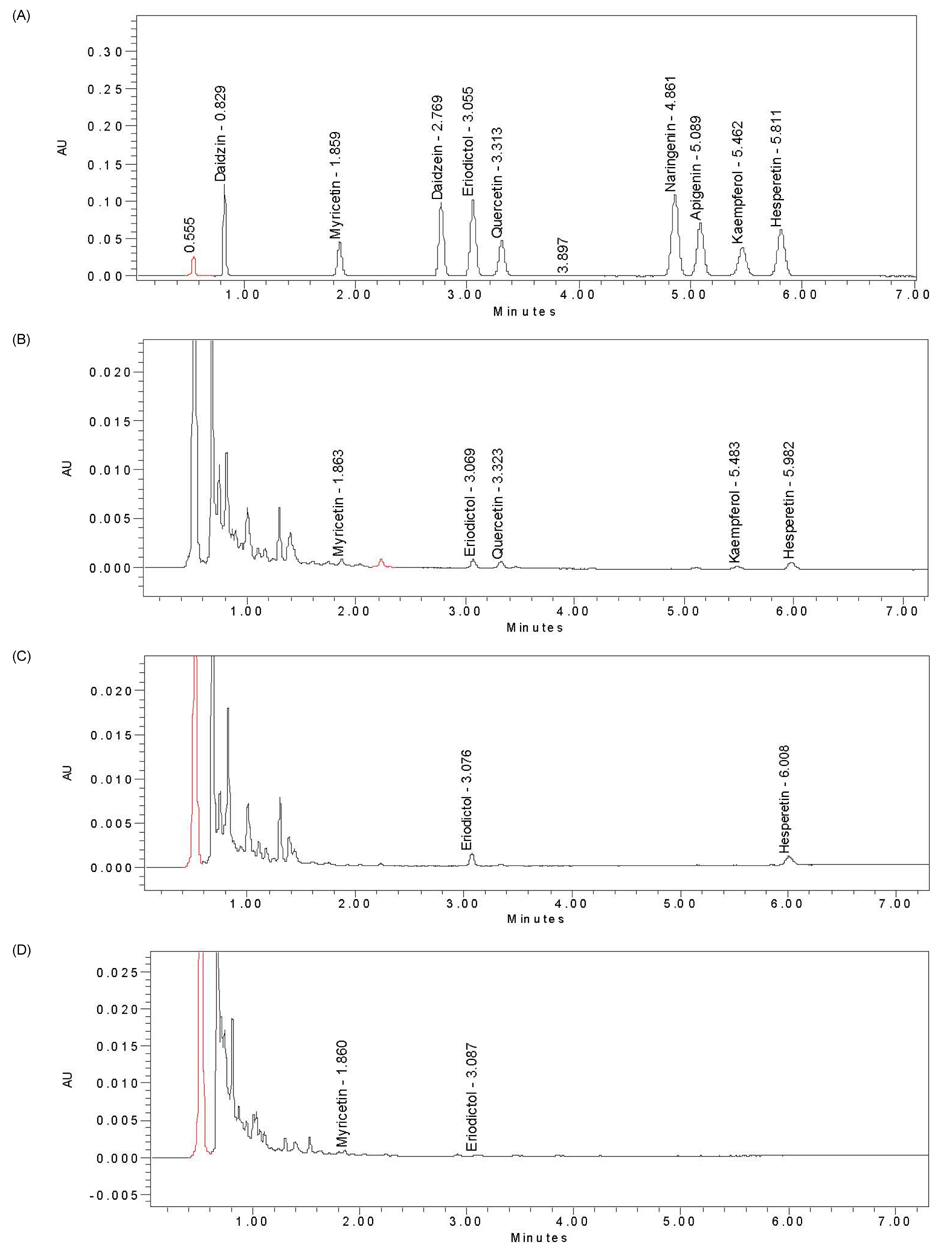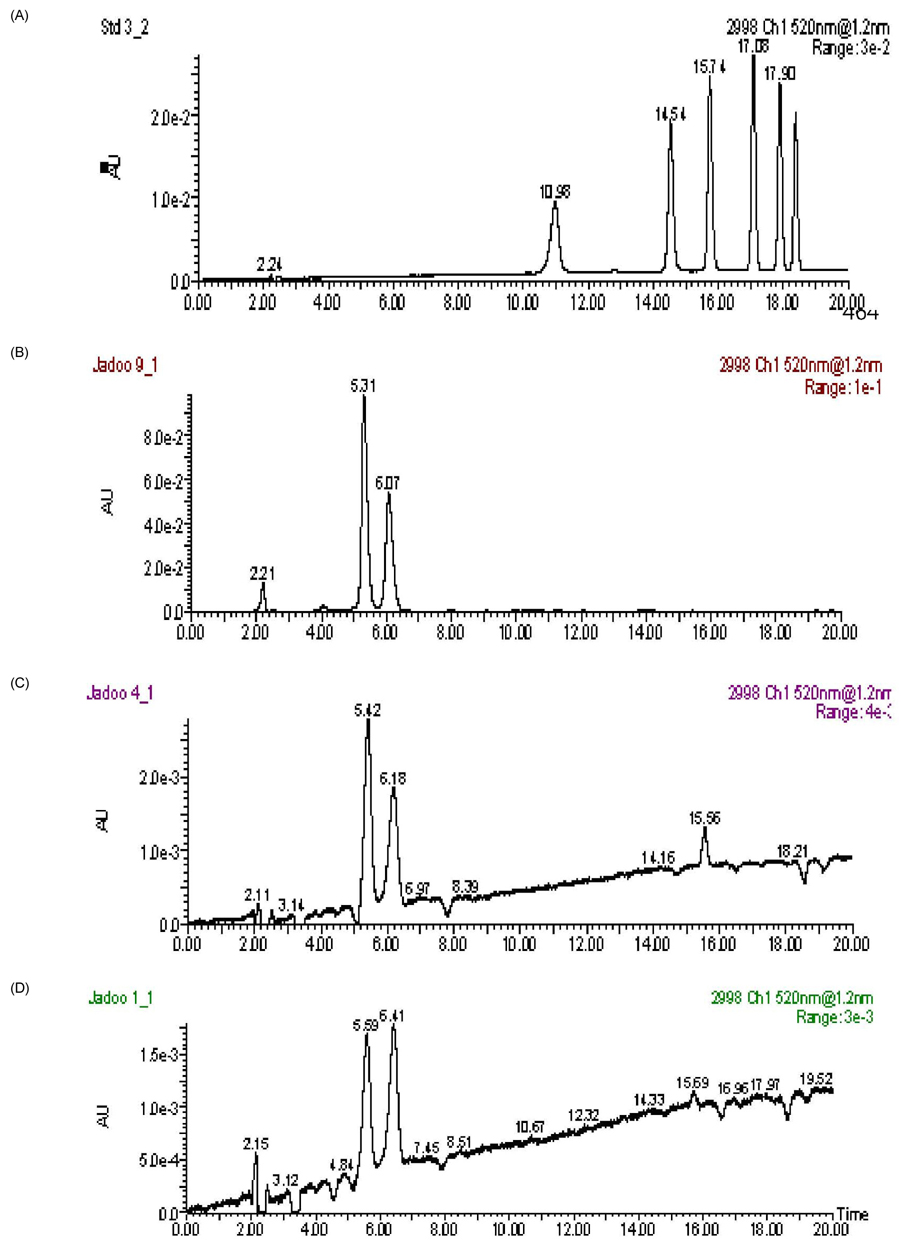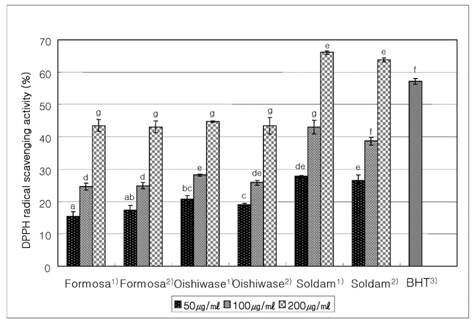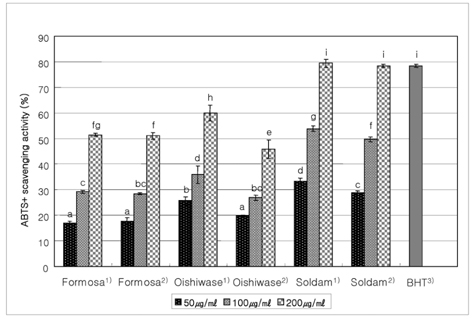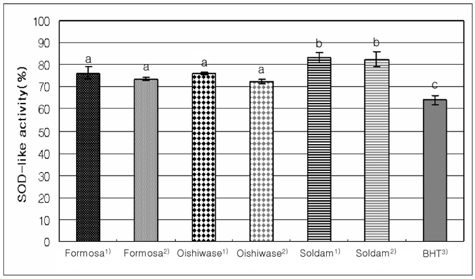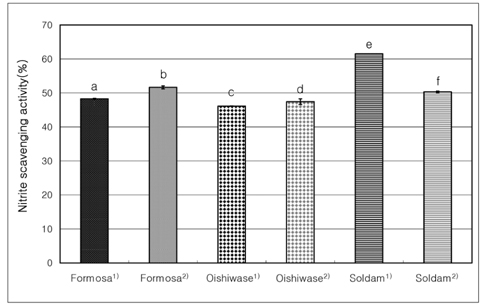Nutr Res Pract.
2012 Aug;6(4):277-285.
Antioxidant activities and determination of phenolic compounds isolated from oriental plums (Soldam, Oishiwase and Formosa)
- Affiliations
-
- 1Department of Agrofood Resources, NAAS, RDA, 88-2, Seodun-dong, Gwonseon-gu, Suwon-si, Gyeonggi 441-853, Korea. gasinali@korea.kr
- 2Department of Food and Nutrition, Chungnam National University, Daejeon 305-764, Korea.
Abstract
- The purposes of this study were to determine phenolic compounds and to evaluate antioxidant activities of plums (Soldam, Oishiwase and Formosa). Soldam contains the highest amount of total phenolics among cultivars (Formosa: 4.0%, Oishiwase: 3.3%, Soldam: 6.4% for total phenolic) as well as the total flavonoids of which constituents were mainly myricetin and anthocyanidin. The antioxidant activities were measured by DPPH, ABTS radical scavenging, and SOD-like activities. The DPPH radical scavenging activity of Korean plum extracts (200 microg/mL) showed more than 43%, and the Soldam turned out to be the highest : ID50 value: 160-177 microg/mL for Formosa and Oishiwase; 58-64 microg/mL for Soldam. The ABTS radical scavenging activity of Korean plum extracts (200 microg/mL) was found to be more than 50%. The SOD-like activity of Korean plum extracts (200 microg/mL) showed more than 70%. Among three kinds of cultivars, Soldam had the highest antioxidant activity. The nitrite scavenging activity of Soldam was 61.5%, which is the highest, compared with that of the other cultivars, about 50%. From these results, Korean plums turned out to be phytochemical rich fruit as well as to show high antioxidant activities.
MeSH Terms
Figure
Reference
-
1. Kim MH, Kang WW, Lee NH, Kwoen DJ, Choi UK. Antioxidant activities of extract with water and ethanol of Perilla frutescens var. acuta kudo leaf. J Korean Soc Appl Biol Chem. 2007. 50:327–333.2. Kedziora J, Bartosz G. Down's syndrome: a pathology involving the lack of balance of reactive oxygen species. Free Radic Biol Med. 1988. 4:317–330.
Article3. Cross CE, Halliwell B, Borish ET, Pryor WA, Ames BN, Saul RL, McCord JM, Harman D. Oxygen radicals and human disease. Ann Intern Med. 1987. 107:526–545.
Article4. Sözmen EY, Tanyalçin T, Onat T, Kutay F, Erlaçin S. Erlacin, Sl. Ethanol induced oxidative stress and membrane injury in rat erythrocytes. Eur J Clin Chem Clin Biochem. 1994. 32:741–744.5. Frei B. Natural Antioxidants in Human Health and Disease. 1994. San Diego: Academic Press;25–55.6. Mavelli I, Ciriolo MR, Rotilio G, De Sole P, Castorino M, Stabile A. Superoxide dismutase, glutathione peroxidase and catalase in oxidative hemolysis. A study of Fanconi's anemia erythrocytes. Biochem Biophys Res Commun. 1982. 106:286–290.
Article7. Blois MS. Antioxidant determinations by the use of a stable free radical. Nature. 1958. 181:1199–1200.
Article8. Sen CK. Oxidants and antioxidants in exercise. J Appl Physiol. 1995. 79:675–686.
Article9. Di Carlo G, Mascolo N, Izzo AA, Capasso F. Flavonoids: old and new aspects of a class of natural therapeutic drugs. Life Sci. 1999. 65:337–353.
Article10. Havsteen B. Flavonoids, a class of natural products of high pharmacological potency. Biochem Pharmacol. 1983. 32:1141–1148.
Article11. Ahn SI, Heuing BJ, Son JY. Antioxidative activities and nitrite-scavenging abilities of some phenolic compounds. Korean J Food Cookery Sci. 2007. 23:19–24.12. Jayaprakasha GK, Jaganmohan Rao L, Sakariah KK. Antioxidant activities of flavidin in different in vitro model systems. Bioorg Med Chem. 2004. 12:5141–5146.
Article13. Peng ZF, Strack D, Baumert A, Subramaniam R, Goh NK, Chia TF, Tan SN, Chia LS. Antioxidant flavonoids from leaves of Polygonum hydropiper L. Phytochemistry. 2003. 62:219–228.
Article14. Chung YC, Chen SJ, Hsu CK, Chang CT, Chou ST. Studies on the antioxidative activity of Graptopetalum paraguayense E. Walther. Food Chem. 2005. 91:419–424.
Article15. Re R, Pellegrini N, Proteggente A, Pannala A, Yang M, Rice-Evans C. Antioxidant activity applying an improved ABTS radical cation decolorization assay. Free Radic Biol Med. 1999. 26:1231–1237.
Article16. Miller NJ, Castelluccio C, Tijburg L, Rice-Evans C. The antioxidant properties of theaflavins and their gallate esters--radical scavengers or metal chelators? FEBS Lett. 1996. 392:40–44.
Article17. Moon YG, Heo MS. Screening of antioxidative and antibacterial activity from methanol extracts of indigenous plants, Jeju-Island. Korean J Biotechnol Bioeng. 2007. 22:78–83.18. Tomás-Barberán FA, Gil MI, Cremin P, Waterhouse AL, Hess-Pierce B, Kader AA. HPLC-DAD-ESIMS analysis of phenolic compounds in nectarines, peaches, and plums. J Agric Food Chem. 2001. 49:4748–4760.
Article19. Nakatani N, Kayano S, Kikuzaki H, Sumino K, Katagiri K, Mitani T. Identification, quantitative determination, and antioxidative activities of chlorogenic acid isomers in prune (Prunus domestica L.). J Agric Food Chem. 2000. 48:5512–5516.
Article20. Arjmandi BH, Lucas EA, Juma S, Soliman A, Stoecker BJ, Khalil DA, Smith BJ, Wang C. Dried plums prevent ovariectomy-induced bone loss in rats. JANA. 2001. 4:50–56.21. Deyhim F, Stoecker BJ, Brusewitz GH, Devareddy L, Arjmandi BH. Dried plum reverses bone loss in an osteopenic rat model of osteoporosis. Menopause. 2005. 12:755–762.
Article22. Arjmandi BH, Khalil DA, Lucas EA, Georgis A, Stoecker BJ, Hardin C, Payton ME, Wild RA. Dried plums improve indices of bone formation in postmenopausal women. J Womens Health Gend Based Med. 2002. 11:61–68.
Article23. Sung YJ, Kim YC, Kim MY, Lee JB, Chung SK. Approximate composition and physicochemical properties of plum (Prunus salicina). Agric Chem Biotechnol. 2002. 45:134–137.24. Stacewicz-Sapuntzakis M, Bowen PE, Hussain EA, Damayanti-Wood BI, Farnsworth NR. Chemical composition and potential health effects of prunes: a functional food? Crit Rev Food Sci Nutr. 2001. 41:251–286.
Article25. Kim HJ, Yu MH, Lee S, Park JH, Park DC, Lee IS. Effects of plum fruits extracts at different growth stages on quinone reductase induction and growth inhibition on cancer cells. J Korean Soc Food Sci Nutr. 2004. 33:1445–1450.
Article26. Lee IS, Kim HJ, Yu MH, Im HG, Park DC. Antimicrobial activities of 'Formosa' plum at different growth stages against pathogenic bacteria. Korean J Food Preserv. 2003. 10:569–573.27. Utsunomiya H, Takekoshi S, Gato N, Utatsu H, Motley ED, Eguchi K, Fitzgerald TG, Mifune M, Frank GD, Eguchi S. Fruit-juice concentrate of Asian plum inhibits growth signals of vascular smooth muscle cells induced by angiotensin II. Life Sci. 2002. 72:659–667.
Article28. Franklin M, Bu SY, Lerner MR, Lancaster EA, Bellmer D, Marlow D, Lightfoot SA, Arjmandi BH, Brackett DJ, Lucas EA, Smith BJ. Dried plum prevents bone loss in a male osteoporosis model via IGF-I and the RANK pathway. Bone. 2006. 39:1331–1342.
Article29. Kim SN. Analyses nutrients and phytochemicals, and antioxidant, anticancer and anti-inflammatory activities of Korean plums by cultivars [master's thesis]. 2008. Daejeon: Chungnam National University.30. Kim MJ, Song YJ, Kim HR, Lee SR, Sok DE, Kim S, Kim MR. Polyphenol and phytate contents and their relationship to antioxidative activity in soybeans. J East Asian Soc Diet Life. 2009. 19:975–980.31. Cheigh CI, Yoo SY, Chung MS. Efficient flavonoid extraction from apple peel by subcritical water and estimation of antioxidant activity. Korean J Food Nutr. 2011. 24:458–463.
Article32. Gabrielska J, Oszmiański J, Komorowska M, Langner M. Anthocyanin extracts with antioxidant and radical scavenging effect. Z Naturforsch C. 1999. 54:319–324.
Article33. Noh KH, Jang JH, Min KH, Chinzorig R, Lee MO, Song YS. Suppressive effect of green tea seed coat ethyl acetate fraction on inflammation and its mechanism in RAW264.7 Macrophage cell. J Korean Soc Food Sci Nutr. 2011. 40:625–634.
Article34. Jung GT, Ju IO, Choi JS, Hong JS. The antioxidative, antimicrobial and nitrite scavenging effects of Schizandra chinensis RUPRECHT(Omija) seed. Korean J Food Sci Technol. 2000. 32:928–935.35. Park YS, Gorinstein S. Comparative content of some phytochemicals in apples, peaches and pears. Korean J Hort Sci Technol. 2005. 23:Suppl 1. 42.36. Rural Development Administration. National Institute of Horticultural & Herbal Science. Apple, Pear Characteristics of Genetic Resources. 2005. Suwon:37. Kim HK, Kwon YJ, Kim KH, Jeong Y. Changes of total polyphenol content and electron donating ability of Aster glehni extracts with different microwave-assisted extraction conditions. Korean J Food Sci Technol. 2000. 32:1022–1028.38. Yu MH, Lee S, Im HG, Kim HJ, Lee IS. Antioxidant activities of prunus salicina Lindl. cv. Soldam (Plum) at different growth stages. Korean J Food Preserv. 2004. 11:358–363.39. Sanchez-Moreno C. Methods used to evaluate the free radical scavenging activity in foods and biological systems. Food Sci Technol Int. 2002. 8:121–137.
Article40. Miller NJ, Rice-Evans CA. Factors influencing the antioxidant activity determined by the ABTS.+ radical cation assay. Free Radic Res. 1997. 26:195–199.
Article
- Full Text Links
- Actions
-
Cited
- CITED
-
- Close
- Share
- Similar articles
-
- Analysis of Phenolic Acid Content and Antioxidant Activity of Chestnut Honey from Different Regions of Korea
- Antioxidant Compounds Isolated from the Roots of Phlomis umbrosa Turcz.
- Phenolic Compounds Isolated from Opuntia ficus-indica Fruits
- Identification of Phenolic Compounds from Vietnamese Artichoke (Cynara scolymus L.) Leaf and Their Antioxidant Activities
- Total Phenolic Content and Antioxidant Activities of Leaves and Bark Extract of Adenanthera pavonina L.


